Analysis of Rainwater Quality and Temperature Reduction Effects Using Rainwater Harvesting Facilities
Abstract
1. Introduction
2. Methods
2.1. Rainwater Collection Method
2.2. Verification of On-Site Application of Rainwater Collection Facilities
2.2.1. Test Bed Operation
2.2.2. Exclusion of Initial Runoff
2.3. Analysis of Rainwater Quality
2.4. Devices and Methods for Temperature Measurement
3. Results
3.1. Rainwater Storage Facility Water Quality
3.1.1. Water Quality and Assurance Measures of Rainwater Storage Facilities
3.1.2. Water Quality of the Rainwater Storage Tank in the Test Bed
3.2. Temperature Reduction Effect of Parking Lot Surface Sprinkling
3.3. Indoor Temperature Reduction Effect through Mist Spraying
3.3.1. Measurement of Temperature and Humidity Changes Due to Mist Spraying
3.3.2. Temperature and Humidity Measurement Results
4. Discussion
4.1. Water Quality of Rainwater Storage Facilities and Improvement Measures
4.2. Discussion on Temperature Reduction Effect
4.3. Effectiveness and Limitations of the Mist Spraying System
4.4. Proposals for Further Research and Improvement of Rainwater Utilization
5. Conclusions
5.1. Summary of Research Results
5.2. Future Research Directions and Suggestions
Author Contributions
Funding
Data Availability Statement
Conflicts of Interest
References
- Choi, J.S. A Study on Introduction Plan of Water Circulation Facilities Considering Site-Condition; LH Land and Housing Institute: Daejeon, Republic of Korea, 2016; Available online: https://www.codil.or.kr/filebank/original/RK/OTKCRK170404/OTKCRK170404.pdf?stream=T (accessed on 2 December 2023). (In Korean)
- Choi, J.S.; Lee, J.M.; Kang, M.S.; Lim, S.H. A Study on the Promoting Rainwater Utilization in Apartments; LH Land and Housing Institute: Daejeon, Republic of Korea, 2020; Available online: https://www.codil.or.kr/filebank/original/RK/OTKCRK200515/OTKCRK200515.pdf?stream=T (accessed on 2 December 2023). (In Korean)
- Kim, D.J.; Ham, D.H.; Choi, J.S.; Lee, J.M.; Lee, J.H. Analysis on Cost-Benefit of Rainwater Storage Facility through Water Balance Analysis. J. Korean Soc. Hazard Mitig. 2020, 20, 361–367. (In Korean) [Google Scholar] [CrossRef]
- Law on the Promotion and Support of Water Reuse; National Law Information Center: Sejong-si, Republic of Korea, 2020. Available online: https://www.law.go.kr/lsInfoP.do?lsiSeq=259257&efYd=20240724#0000 (accessed on 10 March 2024). (In Korean)
- Mendez, C.B.; Klenzendorf, J.B.; Afshar, B.R.; Simmons, M.T.; Barrett, M.E.; Kinney, K.A.; Kirisits, M.J. The effect of roofing material on the quality of harvested rainwater. Water Res. 2011, 45, 2049–2059. [Google Scholar] [CrossRef] [PubMed]
- Yaziz, M.I.; Gunting, H.; Sapari, N.; Ghazali, A.W. Variations in rainwater quality from roof catchments. Water Res. 1989, 23, 761–765. [Google Scholar] [CrossRef]
- Gikas, G.D.; Tsihrintzis, V.A. Assessment of first-flush roof runoff water quality and rainwater harvested. J. Environ. Manag. 2012, 94, 123–134. [Google Scholar] [CrossRef]
- Patzold, F.; Hofmann, M.; Schlünzen, K.H. Heat waves: A hot topic in climate change research. Theor. Appl. Climatol. 2021, 146, 781–800. [Google Scholar]
- Raimondi, A.; Quinn, R.; Gnecco, I.; Ostfeld, A. New Advances in Rainwater Harvesting and Treatment. Water 2020, 12, 1075. [Google Scholar] [CrossRef]
- Oh, Y.T.; Baek, W.O.; Choi, J.S. Demonstration of Reduction of Living Pollutants Using Urban Water Circulation and IoT Technology; Ministry of Environment: Sejong-si, Republic of Korea, 2021. Available online: https://ecoplus.keiti.re.kr:9443/pms/rin/main/rin_0102.jsp?PROJ_RQST_NO=ARQ201902127&PROJ_ANN=2&prevUrl=pop (accessed on 10 March 2024). (In Korean)
- Kim, I.H.; Kim, Y.M.; Lee, J.H.; Moon, J.S.; Park, J.B.; Kim, H.N.; Lee, T.G. Development of Technology for Design and Management of Rainwater Facility; Korea Institute of Civil Engineering and Building Technology: Goyang-si, Republic of Korea, 2011; Available online: https://scienceon.kisti.re.kr/srch/selectPORSrchReport.do?cn=TRKO201200001768 (accessed on 2 April 2024). (In Korean)
- Ministry of Environment. Enforcement Rules of the Act on the Promotion and Support of Water Reuse; National Law Information Center: Sejong-si, Republic of Korea, 2020. Available online: https://www.law.go.kr/lsInfoP.do?lsiSeq=264363&efYd=20240724#0000 (accessed on 12 April 2024). (In Korean)
- Ministry of Environment. Administrative Rules Related to Water Reuse. Available online: https://www.law.go.kr/admRulLsInfoP.do?chrClsCd=&admRulSeq=2100000209158 (accessed on 23 September 2024). (In Korean)
- Ministry of Environment. Rainwater Utilization Facility Installation and Management Guidebook. 2010. Available online: https://www.korea.kr/archive/expDocView.do?docId=26266#expDoc (accessed on 13 April 2024). (In Korean)
- Choi, J.S.; Lee, W.T.; Kim, I.T. Water Reuse Technology for Smart Water Microgrid; Korea Institute of Construction Technology: Goyang-si, Republic of Korea, 2013; Available online: https://scienceon.kisti.re.kr/srch/selectPORSrchReport.do?cn=TRKO201600004135 (accessed on 28 April 2024). (In Korean)
- Ministry of Environment. Guidelines for Design and Maintenance of Water Reuse Facilities. 2013. Available online: https://news.seoul.go.kr/env/archives/33838 (accessed on 28 April 2024). (In Korean)
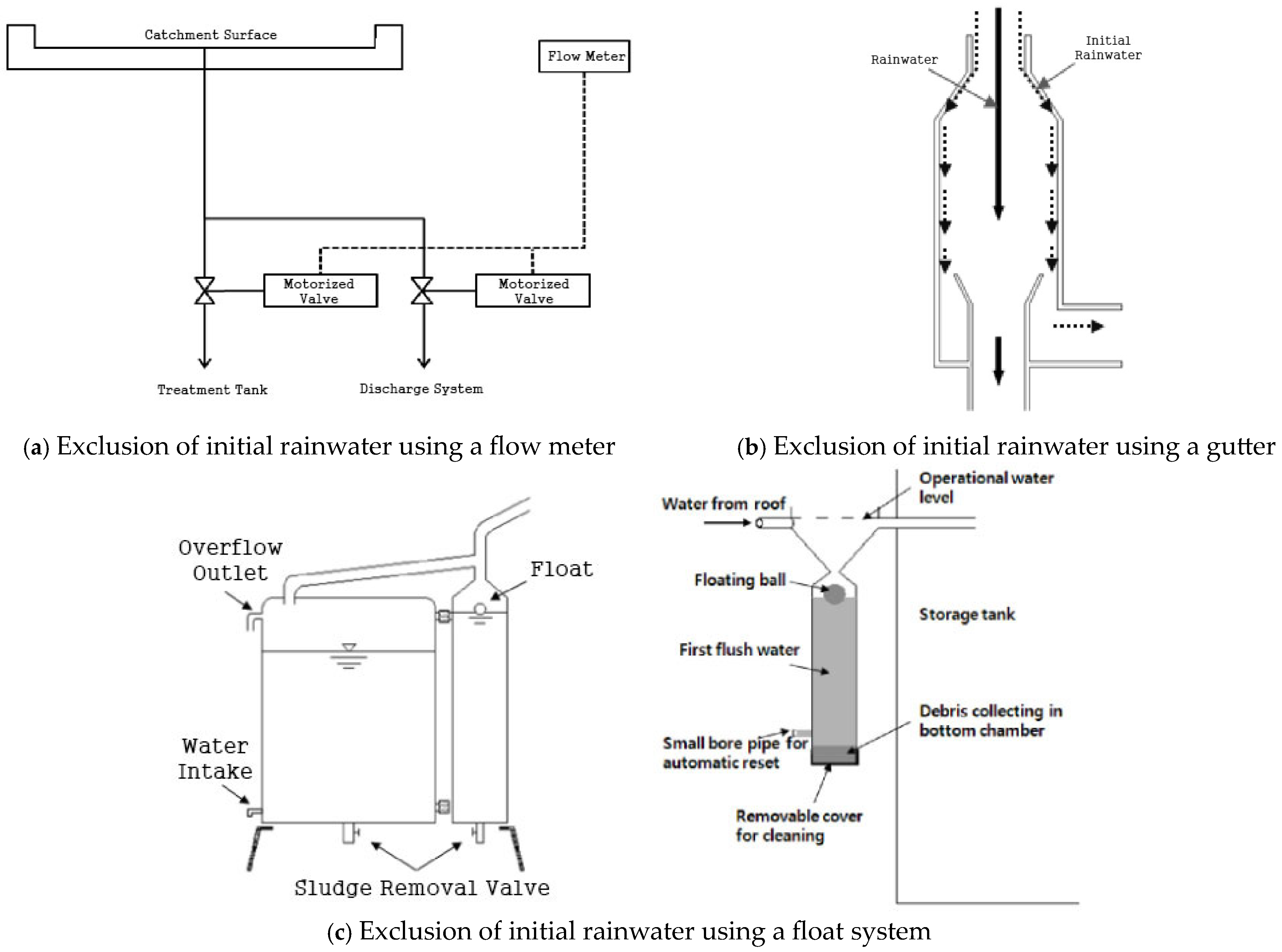


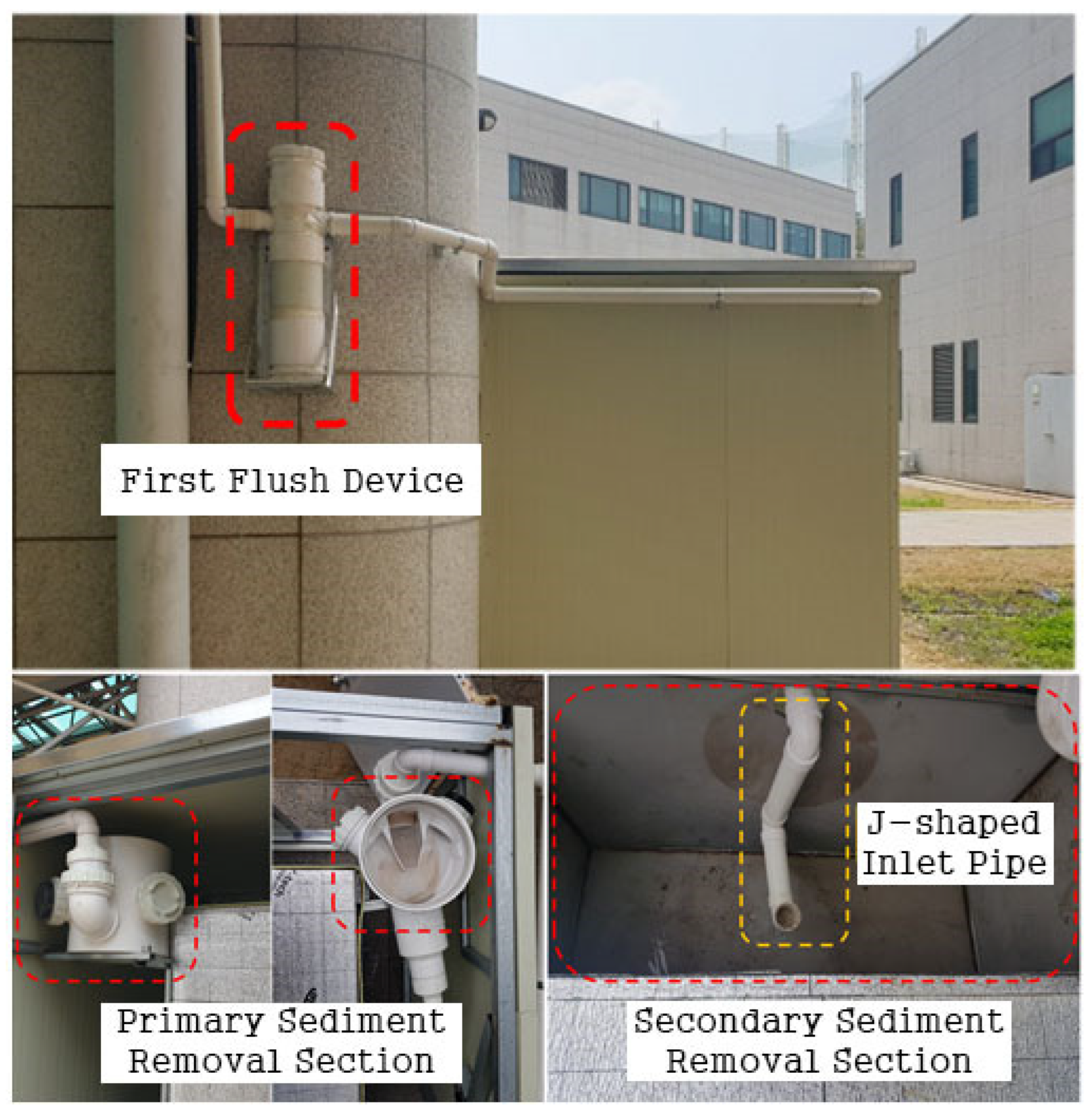
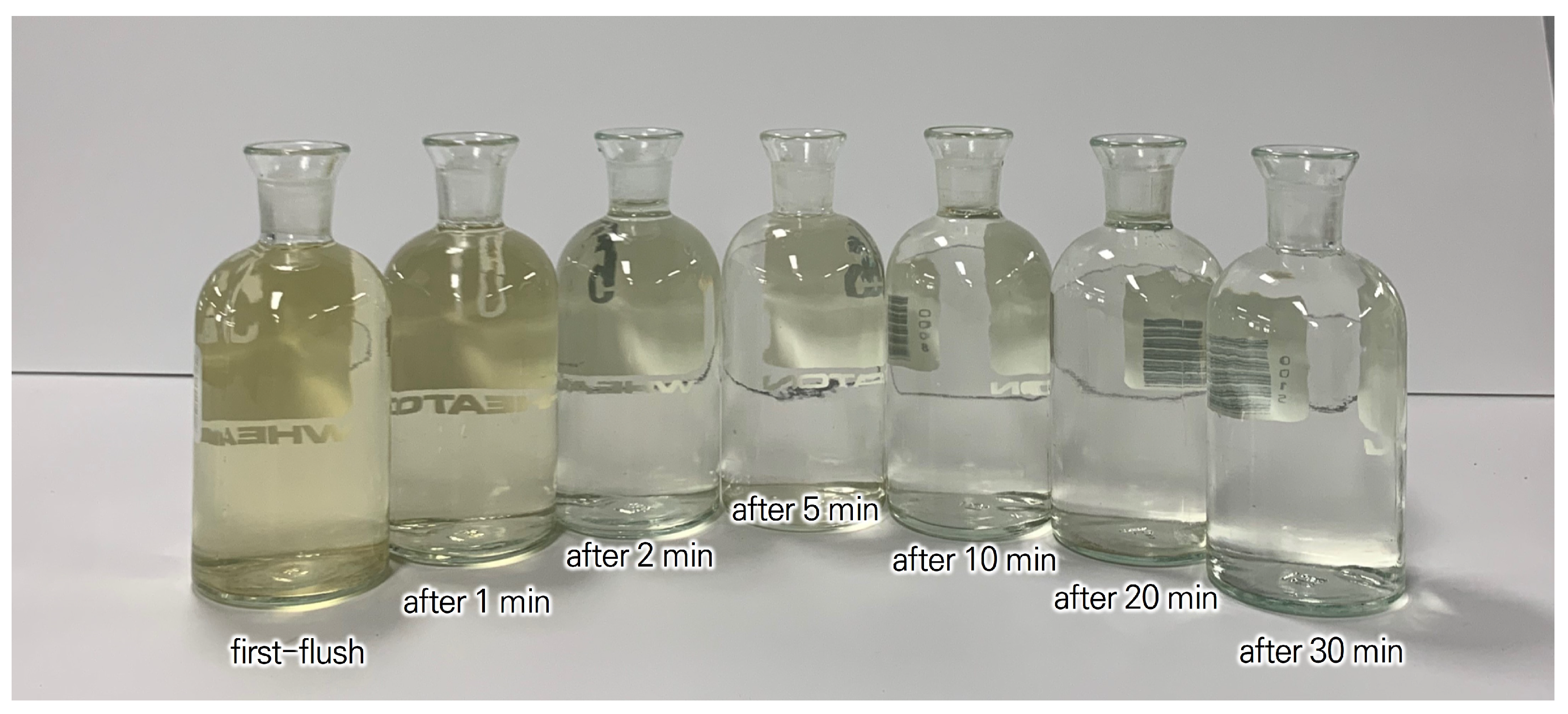
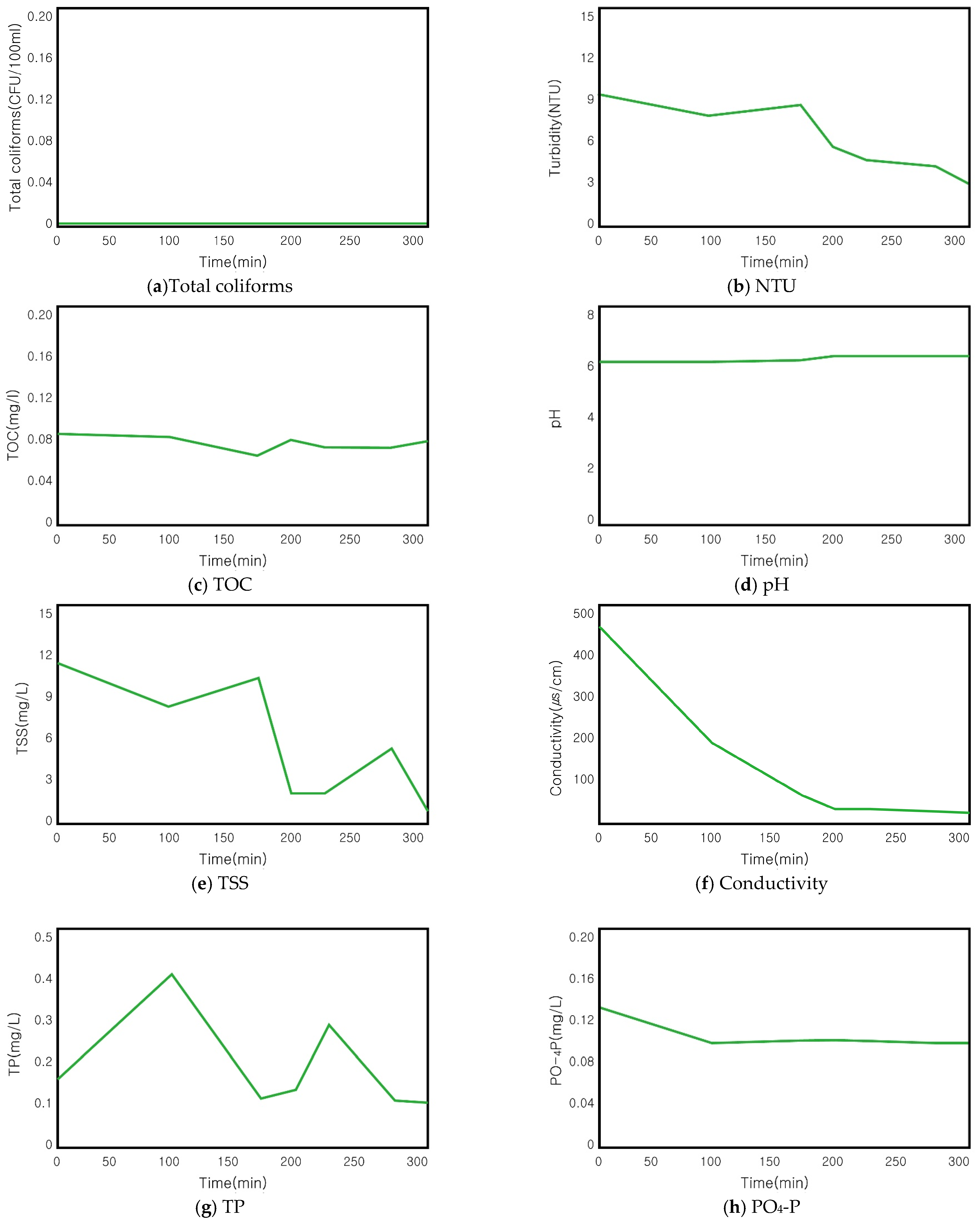

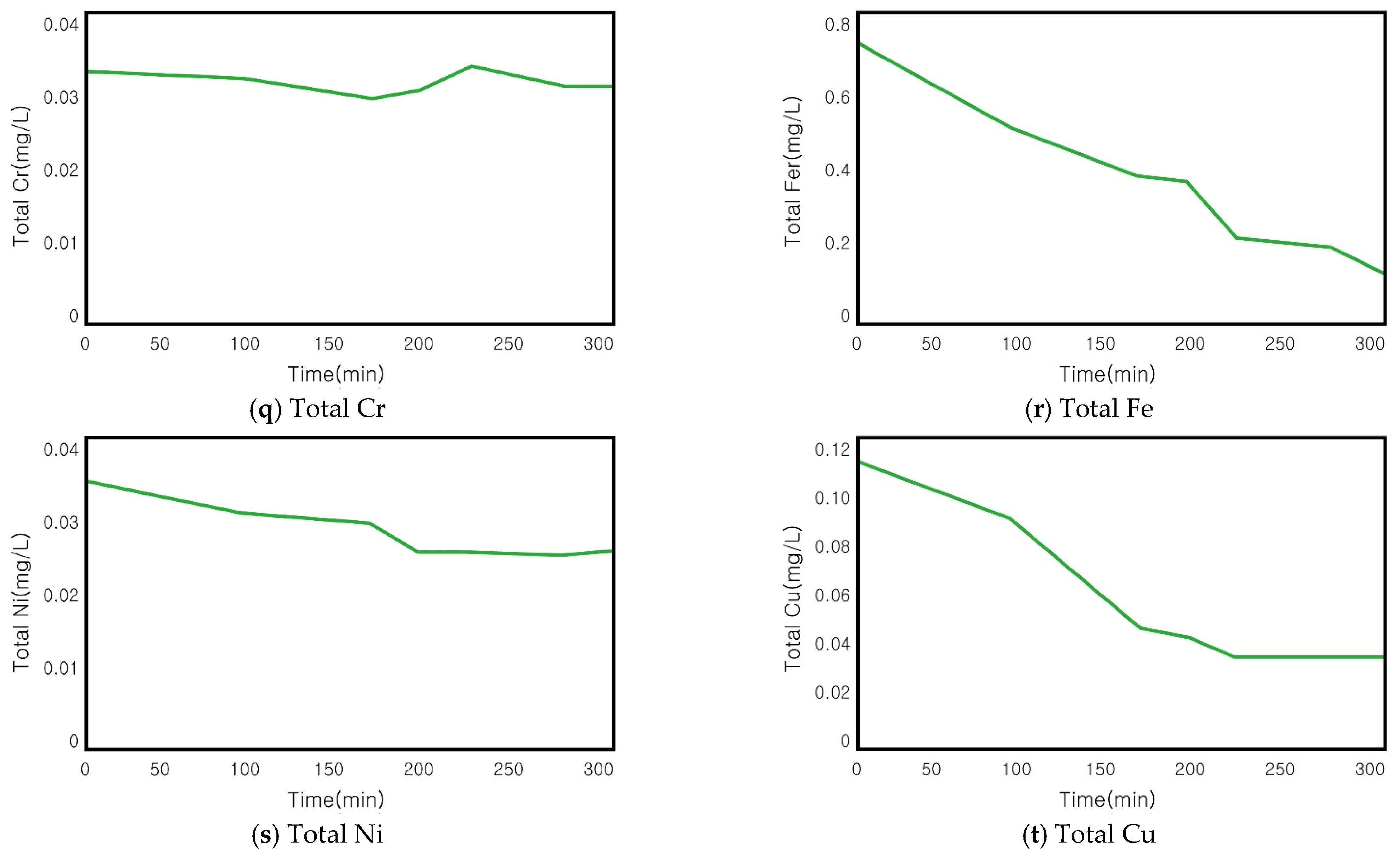
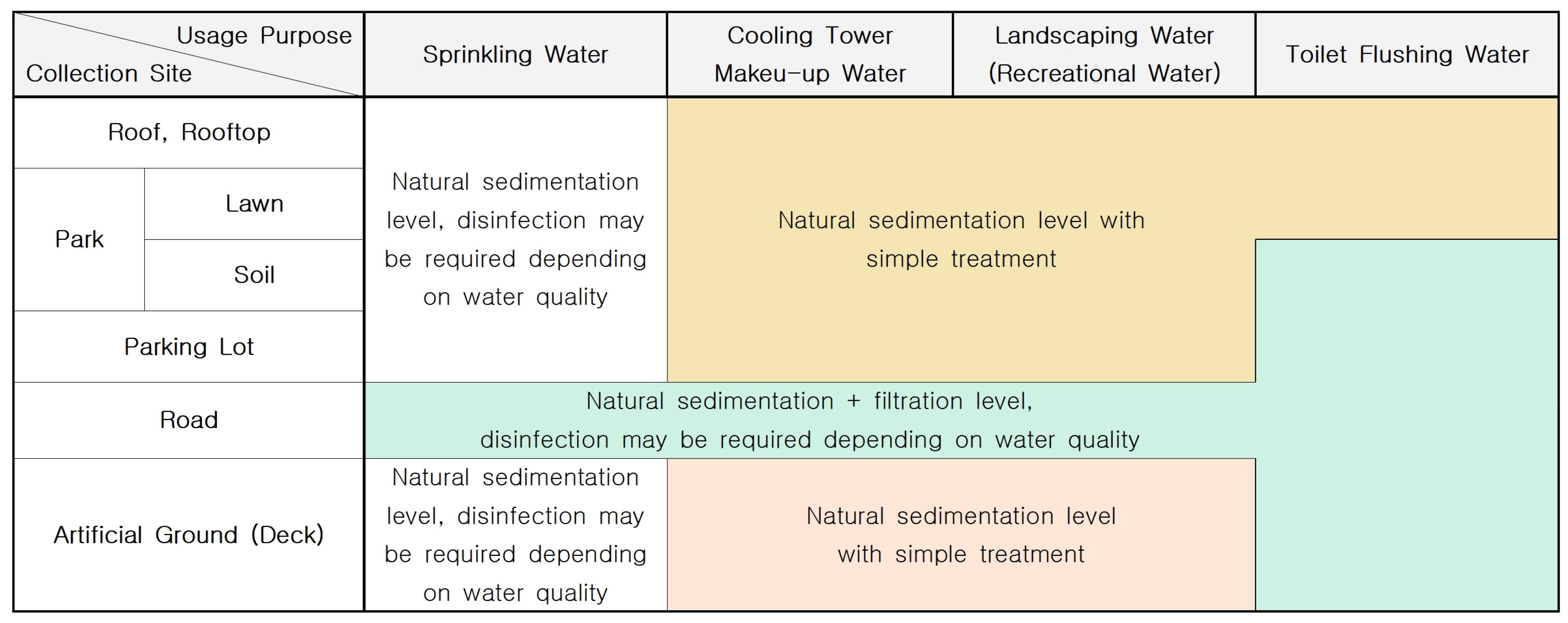
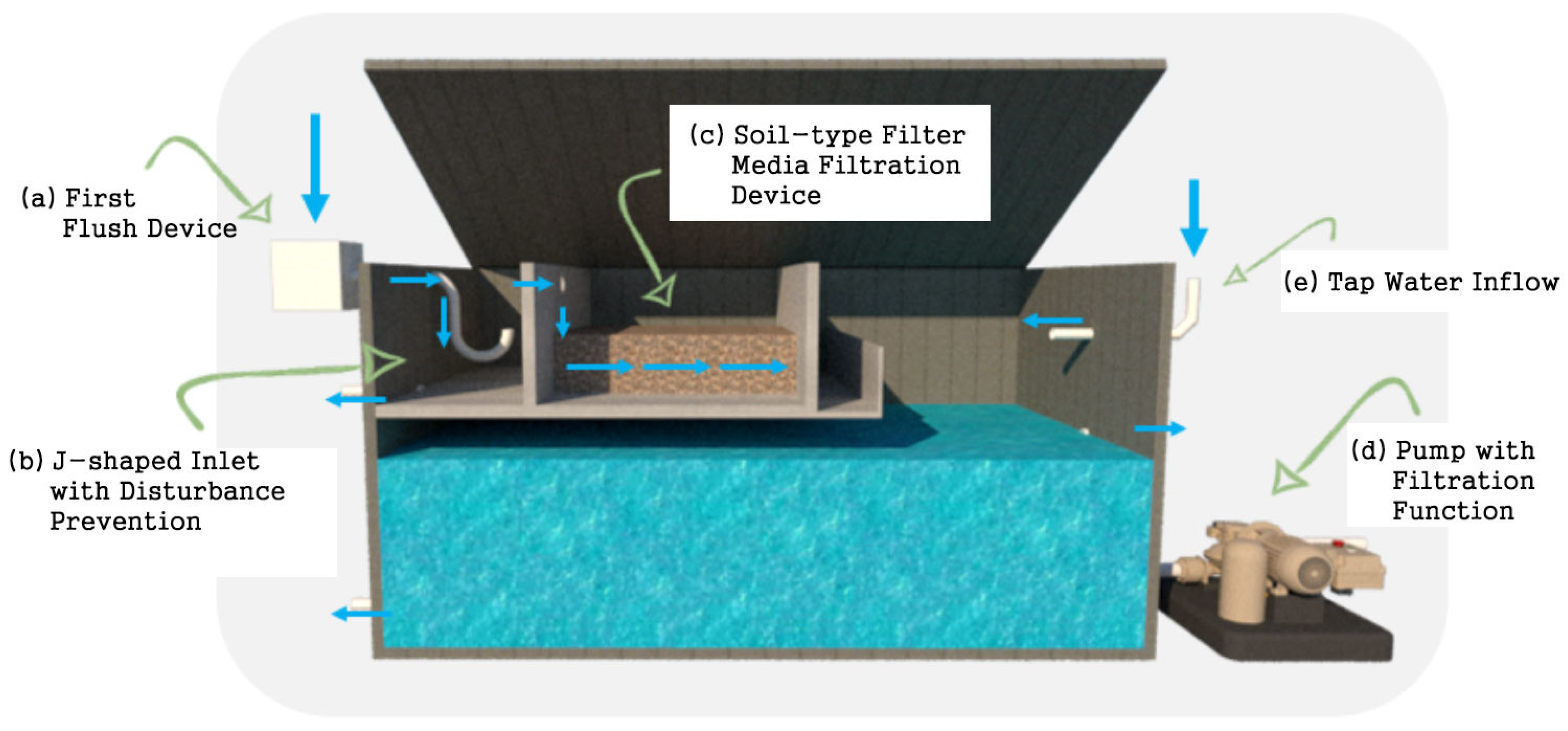
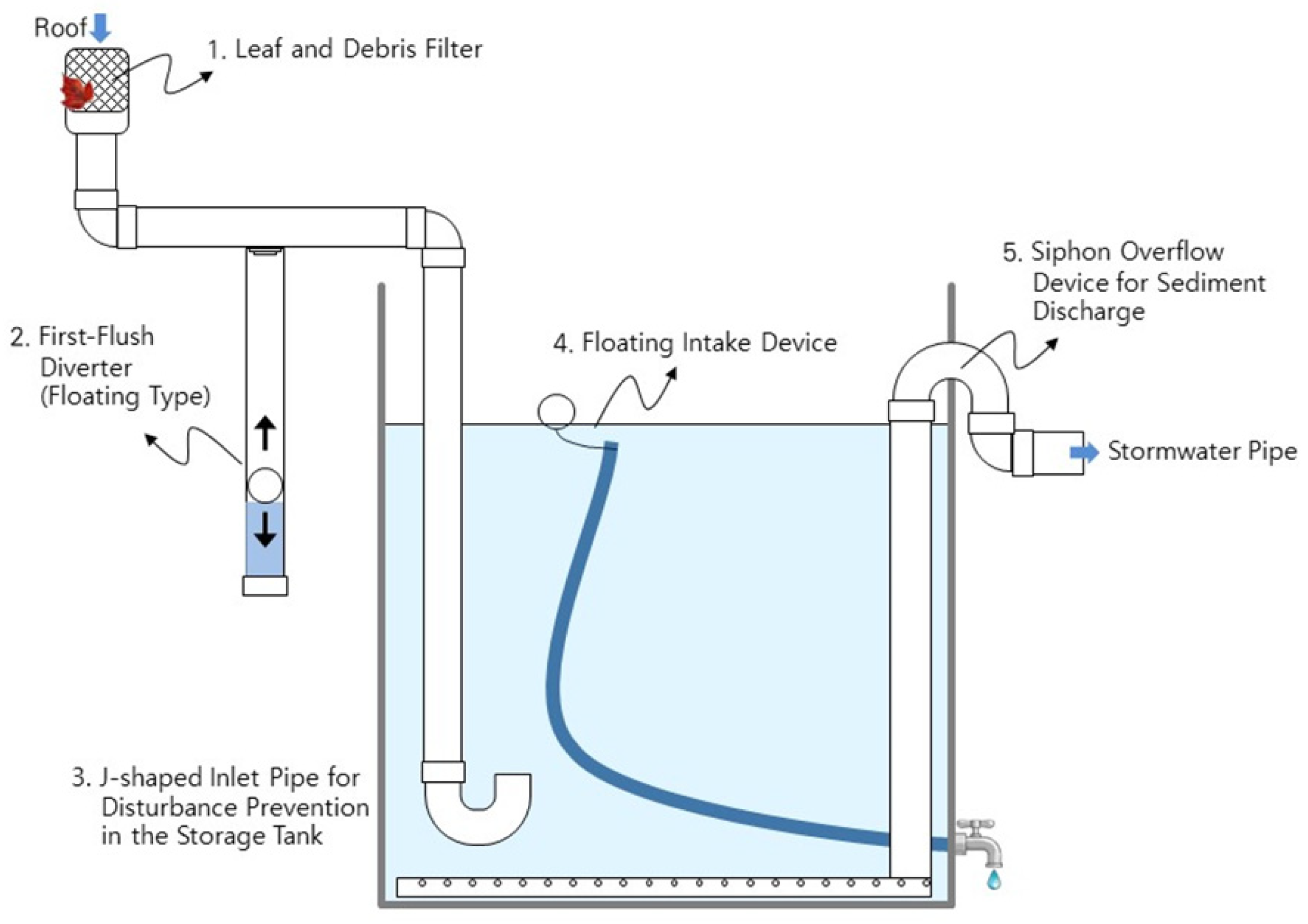
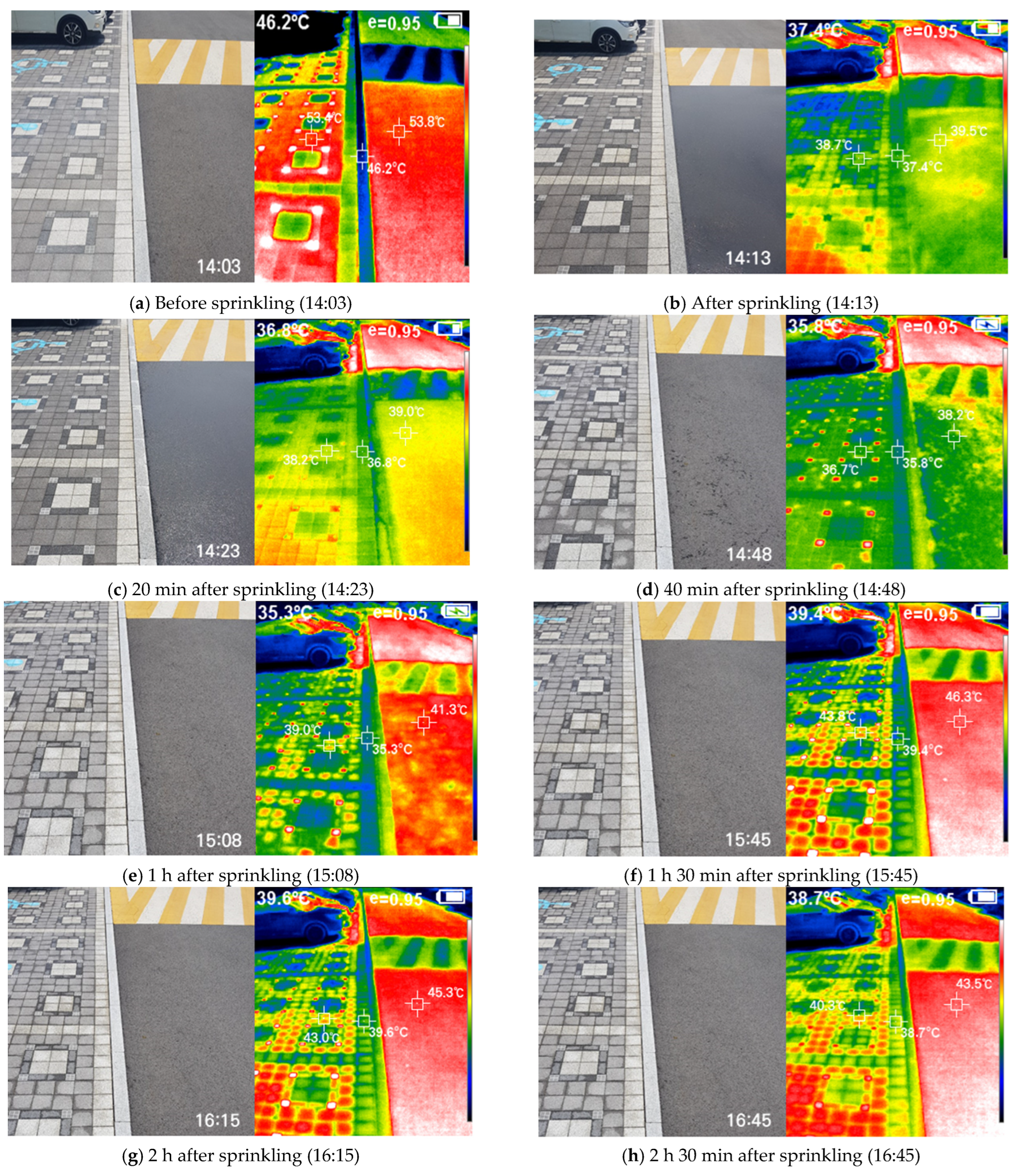
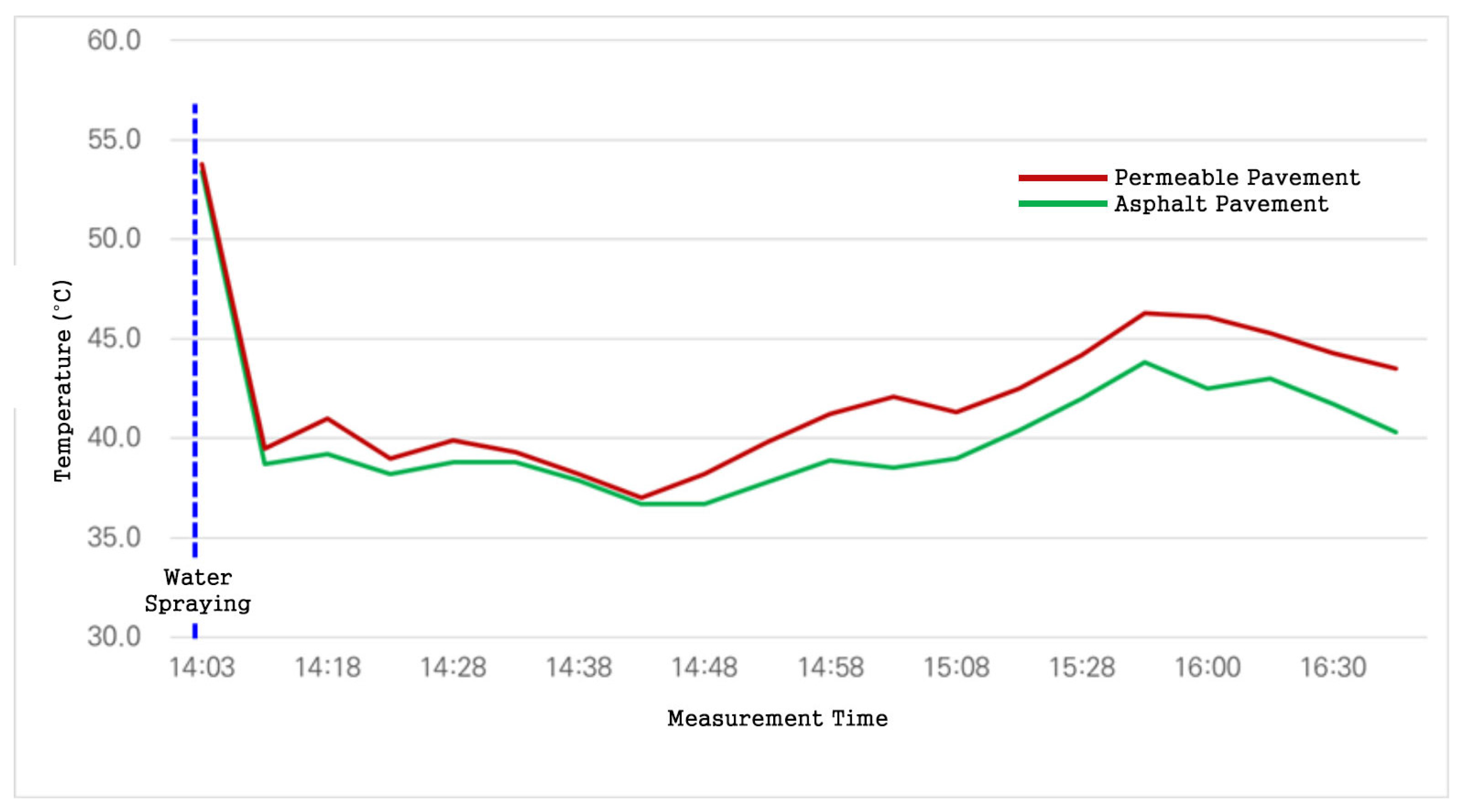


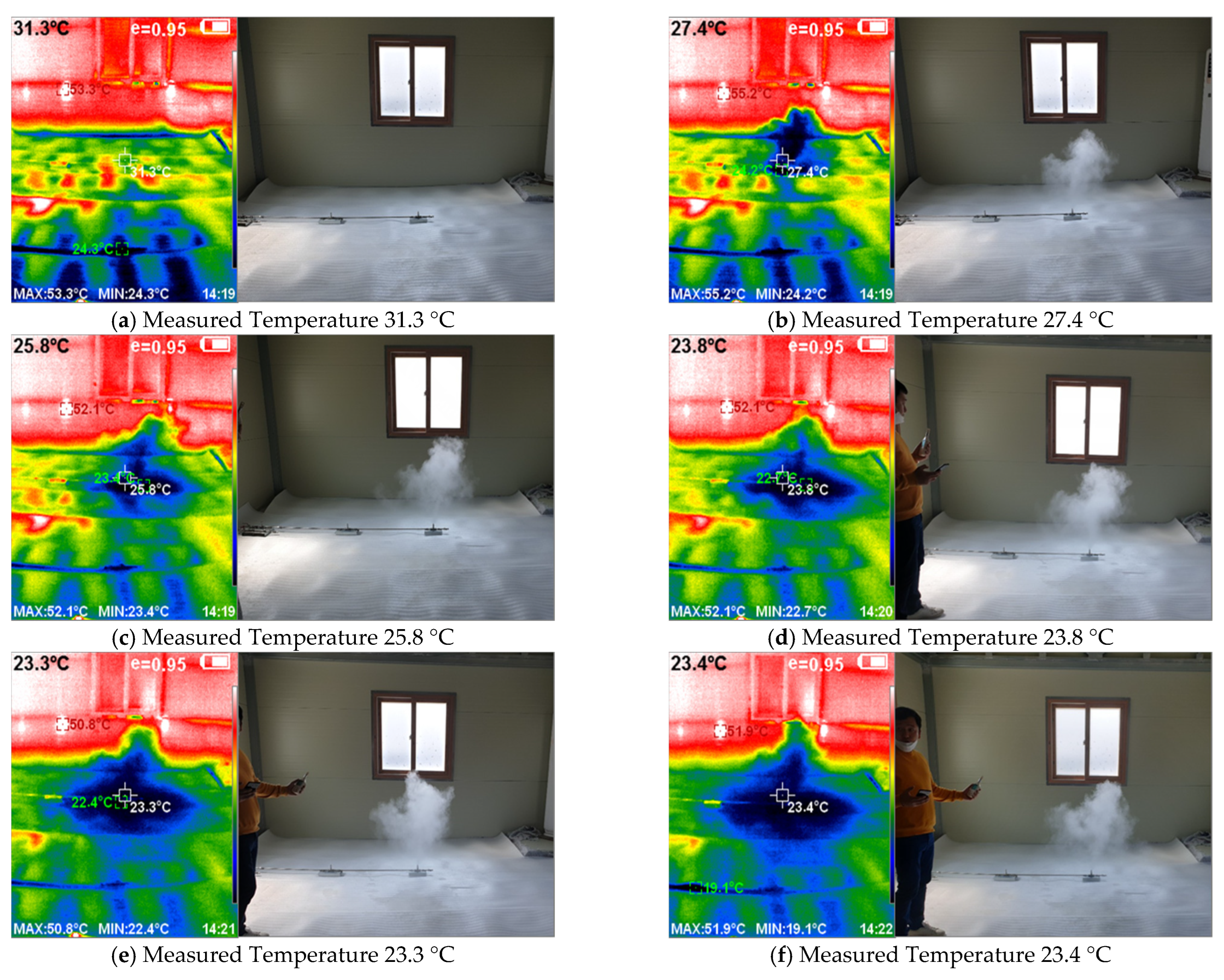
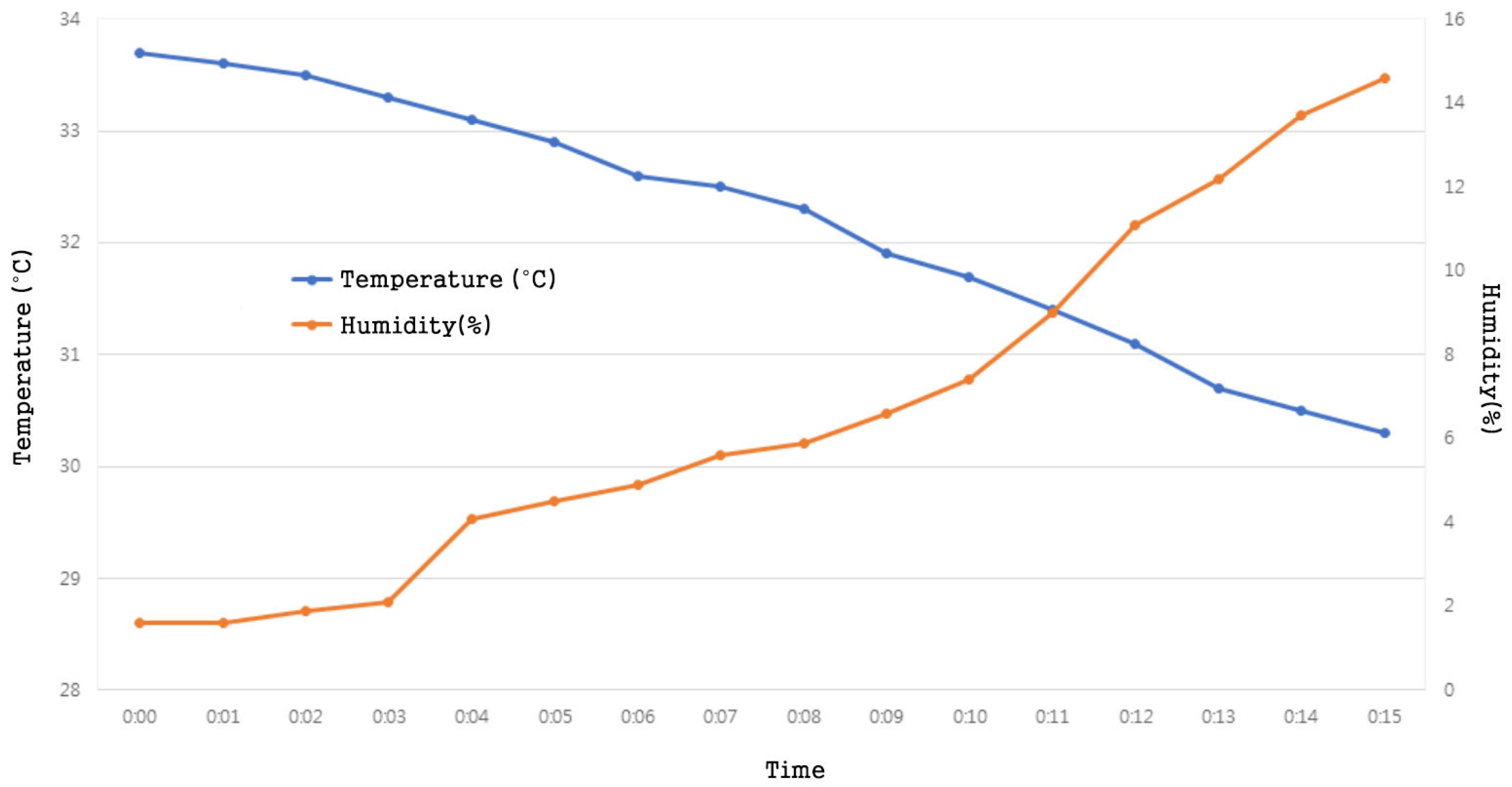
| Category | Location | Catchment Area | Storage Tank Capacity | Usage | Operational Objectives |
|---|---|---|---|---|---|
| Building | Land and Housing Research Institute | rooftops or canopy | 3 m3 | Landscaping water, road sprinkling water | Exclusion of initial runoff, water quality analysis, heatwave mitigation effects, consideration of water reuse methods |
| Digital Temperature and Humidity Meter | Thermal Imaging Camera | ||
|---|---|---|---|
 | 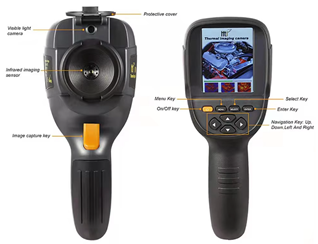 | ||
| Measurement Temperature/Humidity Range | −10~50 °C/ 5~98% | Infrared Image Resolution | 320 × 240 (76,800 pixels) |
| Minimum Scale | 0.1 °C, 1% | Video Image Resolution | 0.3 Megapixels |
| Error Range | ±1 °C, ±3% | Field Angle/Focal Length | 27° × 35°/4.0 mm |
| Power | 9 V, 1 EA | Thermal Sensitivity | 0.07 °C |
| Size (mm) | 207 × 70 × 29 | Temperature Measurement Range | −20~+300 °C |
| Type | Sensor Fixed Type | Temperature Measurement Accuracy | ±2% or ±2 °C |
| - | - | Emissivity | 0.1~1.0 Adjustable |
| - | - | Thermal Image Frame Rate | 9 Hz |
| - | - | Wavelength Range | 8~14 μm |
| Water Quality Item | Greywater Quality Standards [16] | Seoul S Middle School | Goyang J Elementary School | Goyang K Research Institute | Gangneung K Building | Seoul S Complex Building | This Study | |
|---|---|---|---|---|---|---|---|---|
| Washing Water | Landscaping Water | |||||||
| Total Coliform (CFU/100 mL) | 1000 below | 1000 below | Not detected | Not detected | Not detected | Not detected | Not detected | Not detected |
| Fecal Coliform (CFU/100 mL) | - | - | Membrane filtration | Membrane filtration | 0.34 | - | ||
| Turbidity (NTU) | Two below | Two below | 0.43 | 0.129 | 0.68 | 0.85 | 0.5 | |
| BOD (mg/L) | Five below | Five below | 0.7 | 2.9 | ||||
| T-N (mg/L) | - | - | 0.73 | 0.2 | 1.1 | 2.2 | 1.9 | |
| T-P (mg/L) | - | - | 0.43 | 0.35 | 0.24 | 0.02 | 0.05 | |
| pH | 5.8~8.5 | 5.8~8.5 | 7.6 | 6.19 | 7.23 | 5.3 | 7.9 | 7.5 |
| SS (mg/L) | - | - | 3.5 | 2.3 | 1.4 | 0.7 | ||
| COD (mg/L) | - | - | 3.7 | 1.1 | 8 | 4.6 | 12.0 | |
| DO (mg/L) | - | - | - | |||||
| Color | - | - | 5 | 7 | 5 | 3 | - | |
| Electrical Conductivity (μS/cm) | - | - | 97.8 | 40.7 | 141.3 | 30.0 | 80.0 | |
| Fe (mg/L) | Drinking Water Quality Standards 0.3 below | 0.03 | 0.042 | 0.028 | 0.18 | |||
| Cu (mg/L) | Drinking Water Quality Standards One below | 0.015 | 0.083 | 0.072 | 0.035 | 0.087 | ||
| Zn (mg/L) | Drinking Water Quality Standards Three below | 0.75 | 1.093 | 0.269 | 0.060 | 0.037 | ||
Disclaimer/Publisher’s Note: The statements, opinions and data contained in all publications are solely those of the individual author(s) and contributor(s) and not of MDPI and/or the editor(s). MDPI and/or the editor(s) disclaim responsibility for any injury to people or property resulting from any ideas, methods, instructions or products referred to in the content. |
© 2024 by the authors. Licensee MDPI, Basel, Switzerland. This article is an open access article distributed under the terms and conditions of the Creative Commons Attribution (CC BY) license (https://creativecommons.org/licenses/by/4.0/).
Share and Cite
Choi, J.; Lee, J.; Kim, M.; Lee, J.; Cho, Y. Analysis of Rainwater Quality and Temperature Reduction Effects Using Rainwater Harvesting Facilities. Buildings 2024, 14, 3183. https://doi.org/10.3390/buildings14103183
Choi J, Lee J, Kim M, Lee J, Cho Y. Analysis of Rainwater Quality and Temperature Reduction Effects Using Rainwater Harvesting Facilities. Buildings. 2024; 14(10):3183. https://doi.org/10.3390/buildings14103183
Chicago/Turabian StyleChoi, JongSoo, JungMin Lee, MyeongIn Kim, JaeHyeon Lee, and YoungTae Cho. 2024. "Analysis of Rainwater Quality and Temperature Reduction Effects Using Rainwater Harvesting Facilities" Buildings 14, no. 10: 3183. https://doi.org/10.3390/buildings14103183
APA StyleChoi, J., Lee, J., Kim, M., Lee, J., & Cho, Y. (2024). Analysis of Rainwater Quality and Temperature Reduction Effects Using Rainwater Harvesting Facilities. Buildings, 14(10), 3183. https://doi.org/10.3390/buildings14103183







